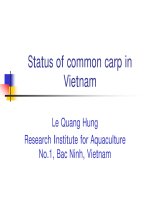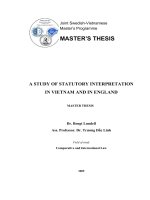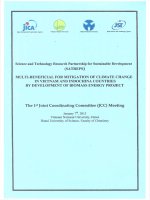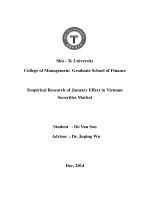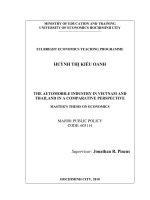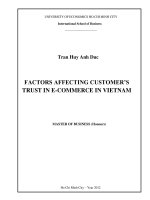Current status of E waste in Vietnam and future goals
Bạn đang xem bản rút gọn của tài liệu. Xem và tải ngay bản đầy đủ của tài liệu tại đây (324.51 KB, 12 trang )
VIETNAM ENVIRONMENT ADMINISTRATION
CURRENT STATUS OF E-WASTE
IN VIETNAM AND FUTURE GOALS
Hanoi 14-17 July 2014
CONTENT
Definition and background
Statistic: Current e-waste management in
Vietnam
Regulations on E-waste in Vietnam
E-waste industries
Certification for hazardous waste treatment
Informal sector: E-waste management craft
village
Future goals
DEFINITION AND BACKGROUND
Environmental protection Law 2005 (or new
version in 2014) gives the definition of hazardous
waste. No specific definition of e-waste
Circular 12/2011/TT-BTNMT (2011) on hazardous
waste management, listed e-waste as hazardous
waste:
Disposed electronic devices or components or
electric devices to have electronic components (code
16 01 13) are hazardous waste in any case
Ewaste is subjected to regulations on
hazardous waste
STATISTIC: CURRENT E-WASTE MANAGEMENT
IN VIETNAM
No survey on e-waste generation
Estimating the number of e-products in the market
(based on their circle life) and waste from e-product
technology
E-waste generated from Electronic industry:
tons
year
REGULATION ON E-WASTE
Law on environmental protection 2005 (new
version in 2014)
Decree 59/2007/ND-CP on solid waste
management
Circular 12/2011/TT-BTNMT on hazardous waste
management
QCVN 07/2009/BTNMT on threshold for
hazardous waste
Decision 50/QD-TTg on take-back and treating
disposed electronic devices
E- WASTE INDUSTRIES
1. Producers
About 400 producers, of which 80% are for export
80% producers import components
2. Collectors/recyclers
o The Urban environment one member limited
company (the URENCO)
o A lot of individual collectors, bring to recyclers or
refurbish company:
Collecting disposed products
Preliminary sorting
Selling to the recyclers or refurbish company
E- WASTE INDUSTRIES
3. Refurbishing companies
o Collecting/Buying used components from
collectors or users
o Refurbishing and selling product
o Re-processing to make new products
o Dismantling the devices/components to get the
profitable parts and selling to the recyclers
o Disposing unusable parts
Refurbishing and then selling as a new products
may be considered as illegal actions (cheating)
E- WASTE INDUSTRIES
4. Recyclers
o To directly use materials from e-waste as an
input for another process
o Valuable components may be sold to repairing
individuals, to be used to replace for other broken
devices or to illegally make a new one with low cost
o Most of valuable parts are manually reprocessed
at craft villages (the informal sectors)
CERTIFICATION FOR HAZARDOUS WASTE
TREATMENT
Nearly 150 companies have been certified (by the
VEA) for transporting and treating hazardous
waste
Among of those15 companies certified companies
to
have
the
e-waste
treatment
system:
(productivity: 0.3 to 2.5 tons/day)
Number of e-waste from electronic industry to be
treated by certified companies is about 20,000 tons
(2012)
However, the performance is not continuous
because of lack of input
INFORMAL SECTOR
CRAFT VILLAGE
There
:E-WASTE RECYCLER AT THE
are approximately 3000 craft villages, but
only 1% (about 30 villages) to have activities on ewaste recycling
Collection: broken devices, imported devices
FUTURE GOALS
Developing a Circular to implementing Decision
50/2013/QD-TTg on the take back system,
promoting the extended producer responsibility
(EPR)
Certification system
Dealing with challenges at the Craft village:
Project on Environmental protection at Craft
villages until 2020
Contact:
Truong, Manh Tuan
Pollution control division for Air and Recyclable
Materials– Pollution Control Department, VEA,
MONRE
Tel.: (84) 904195486; Fax: (84-4) 37713176
Email:
